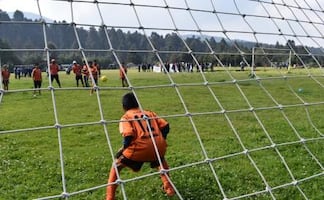An atypical phenomenon
The thousands of tonnes of seaweed spread along the coast stain the shore with an ochre color, which contrasts with the characteristic turquoise blue waters of the Caribbean .
The carpet made out of brown seaweed spreads across at least 6 kilometers along the beaches that distinguish Puerto Morelos , destroying the landscape's beauty and burying the tourists will get into the water.
The presence of seaweed affects the tourism industry ; the fishermen and those who own yachts or sailboats because their ships get stuck in the seaweed, and they can't set sail or return to the port.
What can be seen at Puerto Morelos, Cancún, Playa del Carmen, and Tulum is that the seaweed is concentrated on the shore , in a 3 meters wide strip, that varies depending on the shore's stretch, and is characterized for changing the coast's color to a darker or more intense ochre.
This atypical phenomenon has been studied by scientists from the UNAM's Ocean Sciences and Limnology Institute . The seaweed is 500 meters away from the Mesoamerican Barrier Reef System (SAM) , the second biggest barrier reef in the worl d. This could turn into an “ ecological and economic disaster” , according to Dr. Brigitta van Tussenbroek.
Never ending task
In Puerto Morelos , the arduous work is infinite, as teams of local workers clean the seaweed for hours , which won't go away anytime soon, and on the contrary, it might arrive with more intensity, starting this month.
The task seems endless and it's clear that human hands are not enough to clean this area. The workers collect tonnes of seaweed and put them in wheelbarrows or in trucks, but as soon as they have cleaned it, more weed arrives or gets close to the shore.
Almost by the lighthouse, Juan Gómez Cervantes , employed by Puerto Madero's Public Services , and now a “ seaweed collector ”, is focused on, along with his co-workers, removing the accumulated seaweed.
To carry out this task, he covers his head with a turban made out of a white t-shirt, to protect himself from the sun's cruelty. He wears a short sleeve shirt, but he covers his arms and he protects his eyes from the sand by wearing sunglasses. He has an eye infection and sand affects his view. “ We work hard, non-stop, without a time limit . We try to clean the beach as much as we can, but sometimes you can't beat nature. We try to give the beach another image, that it's cleaner, and more tourism arrives”, he says and adds that if there aren't enough trucks, they bury the seaweed beneath the sand.
The day we interviewed him, they had buried 7 tonnes , according to him. The number corresponds with the 3 kilometers along the Pelicanos, a restaurant, and passing by the lighthouse and a nudist beach. Towards the south of the lighthouse, the cleaning of the “private beaches ” is left to the hotels, he says. “They can't cope either. They'd rather hire employees or companies to clean the seaweed”, he says.
Tourism
Lilia del Carmen
is a therapist. She makes a living by giving massages to tourists in the mall located between Plaza Forum and Salvia condominiums. She used to have 10 clients per day . Now she has 2. She blames the seaweed , which inhibits tourism.
“The seaweed is affecting us because tourists come here to enjoy Cancún's beautiful beaches, but now with the seaweed, they can't get in the water. We used to have 10 clients per day, but now we have 2 or sometimes none”, she says.
“Seaweed baths” in Cancún
Robert
from Peru , and Brat from Wisconsin , US., just had a seaweed bath and are willing to talk about their experience.
They arrived in Mexico 7 days ago . They visited Tulum and then ran away from the seaweed to Playa del Carmen , but they ran into it, and in bigger quantities. They wanted to shelter in Cancún , and the result was the same , but in a smaller quantity.
Robert
says that “what this feels like, when you want to take a bath, we didn't expect it, we're disappointed . During the first days, we were totally away from the beach, and we liked it. But we would like to have the certainty that during our next visit everything will be much cleaner. We don't know what's causing this”.
Although there are tourists who feel cheated by the beaches' promotional images and the ones they find upon their arrival, Westley , from the Netherlands , and his girlfriend , from Tampico , Mexico , understand that this is a natural phenomenon and they're not uncomfortable. Along with another companion, they have enjoyed the sea and the sand, without any issue.
“I think that it should be cleaned for all the tourists, because you see all these pictures and the white beaches and you have a certain expectation, and that's the reason why you come here”, says Westley.
Also, he says that it doesn't bother him , but he understands that some other tourists might feel uncomfortable. His girlfriend agrees with him. “When you google Cancún you see certain pictures, you see clean beaches and when you arrive here it's not what you were shown, but it's OK, it's a natural phenomenon”.
For the young engineer, this is not an issue, but she adds that she ignores what it is about and its health implications , which might spark off certain worries. “You don't know if it could cause some skin problem or if it's going to burn you”, she said.
gm
Noticias según tus intereses
[Publicidad]
[Publicidad]















